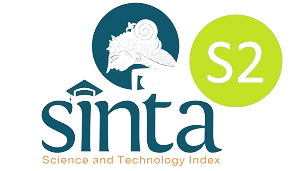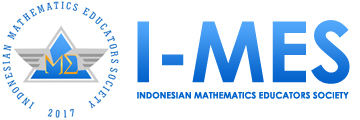Bugis ethnomathematics: Exploration of the sulapa eppa walasuji motif as a source of learning mathematics
DOI:
https://doi.org/10.29408/jel.v11i2.29549Keywords:
Bugis culture, cultural motifs, ethnomathematics, mathematics educationAbstract
Mathematics has historically been integrated into everyday life, and Indonesia's cultural heritage, such as the walasuji of the Bugis community, provides a valuable context for learning. This study explores activities involving mathematical concepts found in the making of walasuji. A descriptive qualitative method with an ethnographic approach was used. Data were collected through observation, documentation, and interviews. The findings reveal that making walasuji involves mathematical concepts such as translation, reflection, rotation, and straight-line equations, offering potential as contextual learning resources in schools. Additionally, the sulapa eppa walasuji motif embodies character values manifested in humans, namely intellectuality (acca), courage (warani), honesty (lempu), and wealth (sugi), referred to as sulapa eppa na taue (the philosophy of a quadrilateral human). Integrating cultural artifacts like walasuji into mathematics learning can enhance students' engagement, cultural awareness, and critical thinking skills. This research implies that future mathematics education should incorporate elements of local wisdom to create meaningful, relevant, and culturally responsive learning experiences, aligning mathematics more closely with students' everyday realities and cultural identities.
References
Abdollah, & Sulo, M. (2018). The meaning of sipakatau sipakalebbi sipakainge in Wajo (A semantical analysis). Jurnal Bahasa, Sastra dan Budaya, 17(2), 79–85.
Bishop, J. (1994). Cultural conflicts in mathematics education: Developing a research agenda. For the Learning of Mathematics Journal, 114(2), 15–18.
Busrah, Z., & Pathuddin, H. (2021). Ethnomathematics: Modelling the volume of solid of revolution at Buginese and Makassarese traditional foods. JRAMathEdu (Journal of Research and Advances in Mathematics Education), 6(4), 331–351. https://doi.org/10.23917/jramathedu.v6i4.15050
D’Ambrosio, U. (2016). An overview of the history of ethnomathematics. In In Current and Future Perspectives of Ethnomathematics as A Program (pp. 5–10). Springer.
Hasbi, H., Indrayana, B., & Dharsono. (2021). Sappo: Sulapa eppa walasuji as the ideas of creation three dimensional painting. Dewa Ruci: Jurnal Pengkajian dan Penciptaan Seni, 16(1), 37–46. https://doi.org/10.33153/dewaruci.v16i1.3234
Hendriana, H., Prahmana, R. C. I., & Hidayat, W. (2019). The innovation of learning trajectory on multiplication operations for rural area students in Indonesia. Journal on Mathematics Education, 10(3), 397–408. https://doi.org/10.22342/jme.10.3.9257.397-408
Maryati, & Prahmana, R. C. I. (2019). Ethnomathematics: Exploration of the muntuk community. International Journal of Scientific and Technology Research, 8(6), 47–49.
Mattulada, A. (1985). Latoa: Satu lukisan analitis terhadap antropologi politik orang Bugis [Latoa: An analytical painting of the political anthropology of the Bugis people]. Gajah Mada University Press.
Maulani, F. I., & Zanthy, L. S. (2020). Analisis kesulitan siswa dalam menyelesaikan soal materi transformasi geometri [Analysis of students' difficulties in solving geometric transformation material problems]. Jurnal Gammath, 5(1).
Muhtadi, D., Sukirwan, S., Warsito, W., & Prahmana, R. C. I. (2017). Sundanese ethnomathematics: Mathematical activities in estimating, measuring, and making patterns. Journal on Mathematics Education, 8(2), 185–198. https://doi.org/10.22342/jme.8.2.4055.185-198
Nayazik, A. (2024). The validity of student worksheets based on ethno-STEM material on volume of rotating objects. Journal of Medives : Journal of Mathematics Education IKIP Veteran Semarang, 8(2), 313. https://doi.org/10.31331/medivesveteran.v8i2.3016
Pathuddin, H., Kamariah, & Ichsan Nawawi, M. (2021). Buginese ethnomathematics: Barongko cake explorations as mathematics learning resources. Journal on Mathematics Education, 12(2), 295–312. https://doi.org/10.22342/jme.12.2.12695.295-312
Pathuddin, H., Kamariah, & Mariani, A. (2023). Ethnomathematics of Pananrang: A guidance of traditional farming system of the Buginese community. Journal on Mathematics Education, 14(2), 205–224. https://doi.org/10.22342/jme.v14i2.pp205-224
Prahmana, R. C. I., & D’Ambrosio, U. (2020). Learning geometry and values from patterns: Ethnomathematics on the batik patterns of Yogyakarta, indonesia. Journal on Mathematics Education, 11(3), 439–456. https://doi.org/10.22342/jme.11.3.12949.439-456
Prahmana, R. C. I., Yunianto, W., Rosa, M., & Orey, D. C. (2021). Ethnomathematics: Pranatamangsa system and the birth-death ceremonial in yogyakarta. Journal on Mathematics Education, 12(1), 93–112. https://doi.org/10.22342/JME.12.1.11745.93-112
Qastarin, A., & Siagian, M. C. A. (2019). Eksplorasi organza sebagai material utama pada perancangan busana pesta [Exploring organza as the main material in party dress design]. EProceedings of Art & Design.
Rastuti, M., & Prahmana, R. C. I. (2021). The programme for international student assessment research in Indonesia. Jurnal Elemen, 7(2), 232–253. https://doi.org/10.29408/jel.v7i2.3289
Risdiyanti, I., Prahmana, R. C. I., & Shahrill, M. (2019). The learning trajectory of social arithmetic using an Indonesian traditional game. Elementary Education Online, 18(4), 2094–2108. https://doi.org/10.17051/ilkonline.2019.639439
Rosa, M., & Orey, D. (2011). Ethnomathematics : The cultural aspects of mathematics Etnomatemática : Os aspectos culturais da matemática. Revista Latinoamericana de Etnnomatematica, 4(2), 32–54.
Rumi, J. (2017). Sabbe synthesist: Diskursus motif dasar pengembangan sarung sutera Sengkang sebagai identitas dan potensinya dalam industri kreatif [Sabbe synthesist: Discourse on the basic motifs of Sengkang silk sarong development as an identity and its potential in the creative industry]. Jurnal Desain Komunikasi Visual Fakultas Seni Dan Desain Universitas Negeri Makassar, 4(2). https://doi.org/10.26858/tanra.v4i2.4389
Santos, M. (2019). Units of measurement in social practices : An ethnomathematic study marilene santos professora adjunta do departamento de educação da Universidade Federal de Sergipe – UFS – Brasil . Campus Prof . Alberto Carvalho . Vice líder do Grupo de Pesquisa Educaçã. American International Journal of Contemporary Research, 9(2), 32–39. https://doi.org/10.30845/aijcr.v9n2p4
Spradley, J. P. (2007). The ethnographic interview. Waveland Press.
Srikandi, Sahabuddin, E. S., & Amir, F. (2018). Pengembangan desain dan peningkatan produksi kain tenun sutera motif Pucu’ Rebbung [Development of design and increasing production of Pucu' Rebbung motif silk woven fabric]. Prosiding Seminar Nasional Lembaga Pengabdian Kepada Masyarakat Universitas Negeri Makassar.
Suherman, Rahmadani, N. A., Vidákovich, T., Mujib, Fitria, N., Sari Putri, N. I., Addarojat, M. R. U., & Priadi, M. (2021). SQ3R method assisted by ethnomathematics-oriented student worksheet: The impact of mathematical concepts understanding. IOP Conference Series: Earth and Environmental Science, 1796(1). https://doi.org/10.1088/1742-6596/1796/1/012059
Sundawan, M. D. (2018). Kajian kesulitan belajar mahasiswa dalam kemampuan pembuktian matematis ditinjau dari aspek epistimologi pada mata kuliah geometri transformasi [Study of students' learning difficulties in mathematical proof skills viewed from the epistemological aspect in the transformation geometry course]. Jurnal Inovasi Pendidikan Dan Pembelajaran Matematika, 4(2). https://doi.org/10.52166/inspiramatika.v4i1.868
Syarif, Yudono, A., Harisah, A., & Mochsen Sir, M. (2018). Sulapa eppa as the basic or fundamental philosophy of traditional architecture Buginese. SHS Web of Conferences, 41, 1–7. https://doi.org/10.1051/shsconf/20184104005
Umbara, U., Prabawanto, S., & Jatisunda, M. G. (2023). Combination of mathematical literacy with ethnomathematics: How to perspective sundanese culture. Infinity Journal, 12(2), 393–414. https://doi.org/10.22460/infinity.v12i2.p393-414
Wagner, H., Hahn, I., Schöps, K., Ihme, J. M., & Köller, O. (2018). Are the tests scores of the Programme for International Student Assessment (PISA) and the National Educational Panel Study (NEPS) science tests comparable? An assessment of test equivalence in German Schools. Studies in Educational Evaluation, 59(September), 278–287. https://doi.org/10.1016/j.stueduc.2018.09.002
Downloads
Published
How to Cite
Issue
Section
License
Copyright (c) 2025 Andi Aras, Nasruddin, Fawziah Zahrawati B., Syahrul

This work is licensed under a Creative Commons Attribution-ShareAlike 4.0 International License.
Authors who publish with the Jurnal Elemen agree to the following terms:
- Authors retain copyright and grant the journal right of first publication with the work simultaneously licensed under Creative Commons Attribution-ShareAlike 4.0 International License (CC BY-SA 4.0).
- Authors are able to enter into separate, additional contractual arrangements for the distribution of the journal's published version of the work (e.g., post it to an institutional repository or publish it in a book), with an acknowledgment of its initial publication in this journal.
- Authors are permitted and encouraged to post their work online (e.g., in institutional repositories or on their website) prior to and during the submission process, as it can lead to productive exchanges, as well as earlier and greater citation of published work.
Jurnal Elemen is licensed under a Creative Commons Attribution-ShareAlike 4.0 International License





